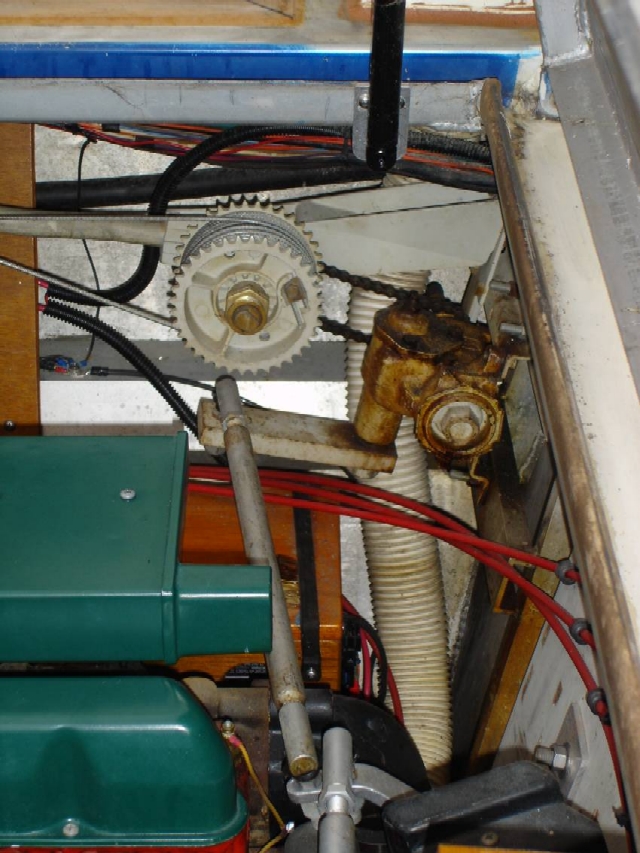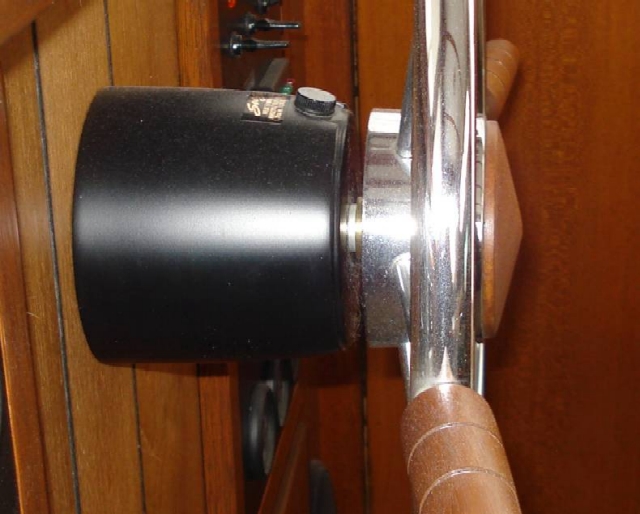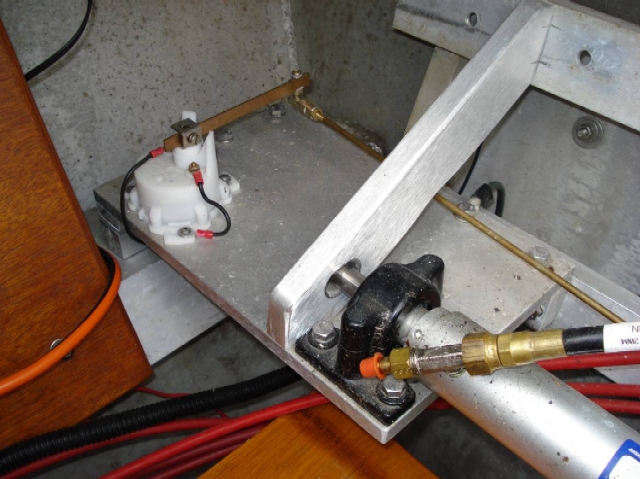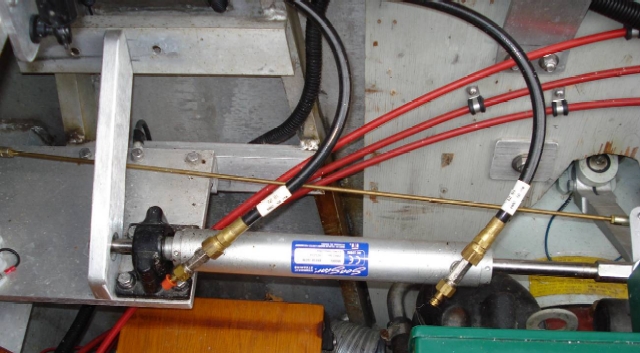Alwest Steering Replacement: by Rob Farrow
As originally built, Catherine Ann (a 1972 Alwest 370 with flybridge) had cable steering much like that seen in older runabouts. Not a push/pull single cable, but actually an entire system of tension cable wrapped around drums at each of the helms and at the chain driven (automotive style) steering box which actuated the outdrives. With over 120 ft of cable running through a maze of guides and pulleys (all 35+ yrs old) the system friction was “substantial”. Steering the boat was actually tiring. Needless to say, after finally changing to hydraulic steering in 2005, I discovered that this was an improvement that I wish I had gotten around to many years before.
As the basics of the new system, I selected two Teleflex Sea Star HH5271 helm pumps and the Teleflex HC 5314 actuating cylinder. This combination has proven to be quite capable of steering the original twin Volvo 270 outdrives which do not have any power assist.
The helm units are essentially positive displacement hydraulic pumps with an internal fluid reservoir. The fluid reservoir is filled (and vented) through a port on the top of the unit. With a twin helm system, it is very important to change the original vented plug in the lower helm to a non-vented plug, or the upper helm reservoir will drain out through the lower helm vent hole. This Sea Star specific plastic plug to replace the vented fitting in the lower helm can be “special ordered” direct from Teleflex for a mere $30.
Seastar brand hydraulic fluid goes for about $25 per litre. The Sea Star installation manual also lists “aviation hydraulic fluid” as an acceptable alternative. This is available at your local municipal airport for less than $10 per litre. (This is what I used)
The spindle taper (where the steering wheel attaches) is apparently now an industry standard, but it is different than my original system, so new wheels or custom made taper adapters will be required.
Mounting the actuating cylinder required considerable fabrication since I was not replacing an existing hydraulic cylinder. Many hydraulic cylinders for twin engine applications are attached to the centre of the tie bar that keeps the outdrives aligned. On Catherine Ann, it made more sense to use the original actuator location in the aft starboard corner and fabricate a new cylinder attachment adapter tying back to the structural braces where the original steering box was mounted. This cylinder is capable of over 1000 lbs of force, so the attachment has to be capable of this, (in both directions).
An additional consideration in mounting this actuating cylinder is provisions for a rudder (outdrive) position indicator since the hydraulic system has no mechanical way to detect cylinder extension. Typically, an electric sending unit operated by the steering arm is connected to an instrument panel gauge. If you have (or are planning the addition of) an autopilot system, these usually have their own rudder position sensor which also needs to be factored into the plan.
Since the hydraulic piping is fixed and the actuating cylinder articulates (a small amount) short sections of appropriate hydraulic hose are required to make sure that the hydraulic connections to the cylinder do not work loose. These hoses are available by special order from Teleflex for about $50 each (or at the local hydraulic supplier for about $10 each).
I also purchased many of the installation fittings from the Teleflex system supplier. When I opened the boxes and looked at these parts, I realized that I could have obtained identical components for a fraction of what I paid, from any local hydraulic component supplier.
To plumb all this together, I chose to use the Sea Star recommended 3/8” soft copper (also known as refrigeration copper) tubing. The main reason for using this type of copper tubing is that it can be shaped by hand and can be bent back and forth (a few times) which is necessary to snake these tubes through the boat from cylinder to helm pump. Commercially available in 50 ft coils, this tubing does not have to be purchased from a marine supplier.
Because of the hydraulic pressures involved, the connection fittings need to be of the flared tube type (like brake lines). Water system compression plumbing fittings will not do the job ! Creating the tube flares required for the correct fittings is actually very easy with the soft copper tubing, but you do need to use a reasonable quality flaring tool.
Consideration must be given to the fact that this is copper tubing being run within an aluminum hull. Any contact between the copper and the aluminum creates the potential for galvanic corrosion. To solve this, and to prevent any abrasion of the copper tubing, I first inserted the measured lengths of copper tubing into equal lengths of new garden hose. This was then routed through the boat as required.
Rob Farrow
Catherine Ann
January 2009





